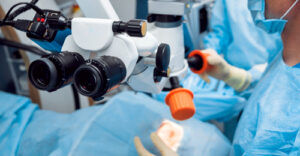Are cataracts making it hard to complete simple, routine tasks? Has poor vision from cataracts made your favorite pastimes less enjoyable?

If so, your eye doctor will likely recommend cataract surgery. There are two options for removing your cataracts: traditional or laser cataract surgery.
Traditional cataract surgery uses handheld blades and is a highly effective procedure. On the other hand, cataract surgery with laser technology is bladeless, offers unmatched precision, and delivers predictable outcomes.
Keep reading to learn more about laser cataract surgery, including eight things you may not know!
How Does Laser Cataract Surgery Work?
Cataracts occur when proteins in your eyes break down and clump together on your lens, making your vision cloudy, blurred, and discolored. Often, cataracts progress gradually and eventually cause blindness without treatment.
Cataract surgery is the only way to restore vision affected by cataracts and get rid of them permanently. During cataract surgery, your cataract surgeon will remove your cloudy natural lens.

Then, they will implant an artificial intraocular lens (IOL) in its place to restore clear vision. Cataract surgery using laser technology can ensure your procedure is more successful.
LenSx femtosecond laser and ORA wavefront technology are among the latest techniques used in cataract surgery. Wavefront eye mapping allows your surgeon to take real-time, precise measurements and make necessary adjustments at any point in surgery.
In turn, this increases your chances of achieving the best possible vision post-surgery without contacts or glasses. If you’re struggling with poor vision from cataracts, you can regain your sight and live life to the fullest with cataract surgery.
Here are eight reasons why you should consider getting laser cataract surgery:
1. Greater Precision
Laser technology creates a detailed, 3-D map of your eye surface. From the information gathered, like the size, location, and depth of the cataract, your surgeon will know exactly where to make the incision.
Surgical incisions with a computer-aided laser are up to 10 times more precise than incisions done by hand.
2. Safer Capsulotomy
Capsulotomy is a vital step in cataract surgery. It involves opening the front part of the delicate, thin membrane or capsule that holds your natural, cloudy lens.
It’s crucial that the portion left inside your eye remains intact. That way, it can hold the new artificial lens in the correct position for clear vision.

Unlike traditional cataract surgery, where the capsule is opened manually, laser cataract surgery utilizes a computer-guided laser to open the capsule. The laser is able to create a more centered and circular opening in your capsule.
Even the most experienced surgeons can’t match the precision of a computer-controlled laser.
3. Uses Less Energy to Break Up Cataracts
During laser cataract surgery, the surgeon uses a laser to soften the cloudy cataract lens. With the cataract softened, less ultrasound energy is required to break and remove it.
Less energy reduces the risk of complications like corneal swelling and clouding or retinal detachment post-surgery.
4. Less Damage to Surrounding Tissue
Breaking up your cataract with a laser uses much less ultrasound energy. As a result, the surrounding tissues don’t suffer as much collateral damage as they would with traditional cataract surgery.
This helps ensure your cornea remains clear and the lens capsule isn’t weakened.
5. Better Vision
Even a slight misalignment of your new intraocular lens can decrease visual quality. The perfect opening made in your capsule by a laser optimizes your surgeon’s ability to accurately place your IOL and attain the best visual outcome.
Thus, you’re more likely not to need contact lenses or glasses after your laser cataract procedure.
6. Can Correct Astigmatism
Astigmatism is a common refractive error. It occurs when your cornea has an egg shape like a football rather than being round like a baseball.

The irregular curvature of the cornea causes blurry or distorted vision at all distances. Your surgeon can treat your astigmatism by reshaping the irregular cornea with a laser.
Laser technology enables your surgeon to perform astigmatism correction more accurately and reliably, leading to better vision outcomes. By removing cataracts and fixing astigmatism simultaneously, many patients are able to see better than they have in years.
7. Minimally Invasive
Bladeless laser cataract surgery doesn’t use stitches. After removing your cataract and implanting an intraocular lens, the surgeon leaves the tiny incisions to heal on their own.
A no-blade, no-stitch procedure is less-invasive and more comfortable for patients.
8. Easier Recovery
Since laser cataract surgery doesn’t use blades, your eye experiences less trauma. Laser cataract surgery also requires less energy to break up your cataract, reducing post-surgery corneal swelling.
Additionally, the clean, accurate incisions made using a laser reduce the risk of infection. All these things combined allow for a smoother recovery and faster vision restoration.
Cataract Surgery with the ORA System
Sierra Nevada Eye Center is proud to offer the ORA system and LenSx femtosecond laser, the latest in cataract surgery. The ORA system and femtosecond laser allow the experienced cataract surgeons at Sierra Nevada Eye Center provide truly customized procedures with excellent outcomes.
Are you interested in laser cataract surgery? Schedule your cataract screening at Sierra Nevada Eye Center in Carson City, NV, today to find out if it’s time for cataract surgery and whether laser cataract surgery is right for you.


